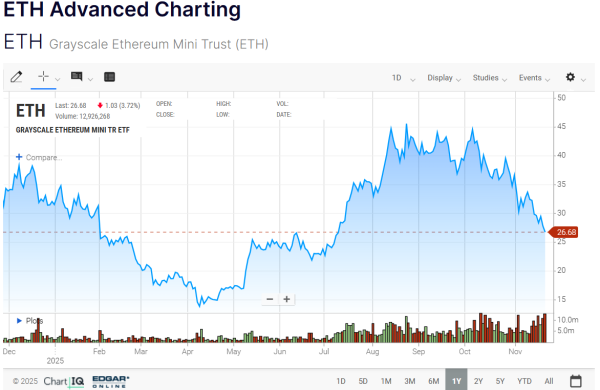Ethereum’s price decline on Thursday has grabbed attention across crypto and broader financial markets. Brokers at Nexdi note that while Ethereum’s move mirrors the pullback seen in many top risk assets, there are additional forces at play that investors need to monitor closely.
As the second-largest cryptocurrency, Ethereum serves as a barometer for the digital asset sector, and a 5.5 % drop in 24 hours signals more than a simple marketwide selloff. Understanding the factors behind this drop, from derivative liquidation to market sentiment, provides insight into both the short-term volatility and the structural dynamics of crypto trading today.
Ethereum Mirrors Broader Risk Asset Weakness
Ethereum (ETH) has experienced significant downward pressure alongside many riskier market assets, including both unprofitable tech firms and highly valued AI companies. Today’s decline reflects a broader sense of caution among investors, who are weighing high spending levels against uncertain profit outcomes in markets where valuations approach historic highs. Even for well-capitalized sectors like AI and cloud infrastructure, elevated risk perceptions have translated into large sell-offs, influencing correlated assets such as Ethereum.
However, Ethereum’s volatility is not solely a reflection of traditional market stress. There are unique crypto-specific factors contributing to its sharp drop, particularly the dynamics of leveraged trading and derivative unwinding.

The Role of Leverage in Ethereum’s Decline
One of the distinguishing features of cryptocurrency markets is the extensive use of leverage via derivatives such as perpetual futures contracts. These instruments allow investors to take magnified bets on Ethereum’s short-term price movements, amplifying both gains and losses. While some market participants use these instruments for hedging large positions, many others engage in speculative trading, reacting to short-term trends and momentum.
Thursday’s sell-off saw a dramatic unwinding of these leveraged positions. According to recent data, long liquidations on Ethereum totaled nearly 150 million dollars within 24 hours, representing a sharp increase over typical daily levels. These forced liquidations magnified downward price pressure, accelerating the market’s decline.
While some analysts view the clearing of speculative positions as a healthy pruning of overextended bets, the broader implication is that high derivative usage continues to increase systemic volatility. For Ethereum, this underscores the ongoing sensitivity of the market to leverage-driven swings.
Market Implications for Crypto Investors
Ethereum’s status as the second-largest cryptocurrency means its movements have a cascading effect on the broader digital asset ecosystem. High-profile liquidations like those seen today often prompt reactions across correlated tokens and derivative markets. The combination of marketwide risk aversion and the unwinding of leveraged positions can create rapid price swings that may not reflect fundamental changes in adoption or technology.
While short-term volatility may appear concerning, it also provides insights into market structure. Specifically, high leverage exposes the sector to amplified swings, but also forces speculative players out of the market, potentially leaving more committed investors with cleaner market dynamics.
Structural Factors Behind Ethereum’s Volatility
Several underlying factors contribute to Ethereum’s sensitivity to market stress:
- Derivative exposure: The widespread use of perpetual futures and other leveraged products increases vulnerability to rapid liquidations.
- Market sentiment: Ethereum, like many crypto assets, reacts strongly to broader risk-off sentiment in equities and high-growth sectors.
- Speculative positioning: Large numbers of short-term traders increase intraday volatility, as highlighted by 150 million dollars in long liquidations on Thursday.
These elements combine to make Ethereum highly reactive to both macroeconomic news and crypto-specific trading activity. Even in periods of strong adoption or technological progress, derivative-driven volatility can dominate price movements.

Navigating Ethereum in a Volatile Market
For investors in Ethereum, the key takeaway is the need to understand both marketwide drivers and crypto-specific risks. Leveraged trading can create explosive moves in either direction, magnifying gains and losses. While Ethereum remains central to decentralized finance, smart contract applications, and the broader digital asset ecosystem, its price behavior continues to be highly sensitive to short-term sentiment and liquidation events.
The events of Thursday highlight the dual nature of cryptocurrency investing: immense opportunity coupled with significant risk from structural market mechanics. For investors with a longer-term perspective, these fluctuations may present opportunities to accumulate or rebalance, but they underscore the importance of risk management and awareness of leverage-driven dynamics.
Conclusion
Thursday’s Ethereum sell-off serves as a reminder that cryptocurrency markets are uniquely sensitive to both broader market conditions and crypto-specific factors. While the 5.5 % decline may alarm some investors, it is largely driven by the unwinding of leveraged bets in an already risk-averse environment.
Monitoring derivative activity, market sentiment, and overall risk appetite remains critical for navigating Ethereum and other major digital assets. Understanding these forces can help investors respond strategically rather than react emotionally to extreme short-term volatility.









